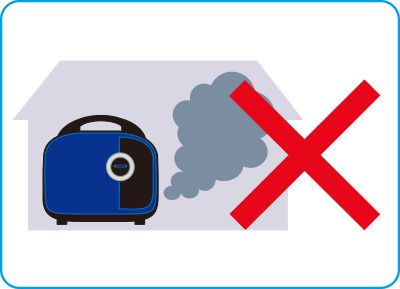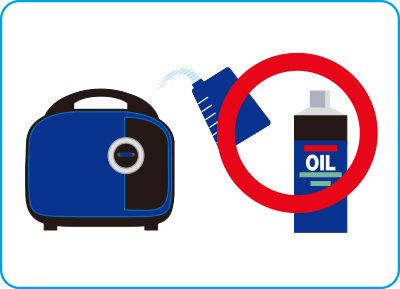To use a generator safely
It is necessary to follow certain precautions and simple inspections while operating the generator.
Prior to operating the generator, it is necessary to read the instruction manual and fully understand the product information, safety information, and cautions in the manual. Otherwise, this may result in improper operation of the generator and could potentially result in a serious accident and/or failure of the generator. Although a user might possess sufficient knowledge about the operation of the generator, it is advisable for all users to carefully read the entire instruction manual prior to running the generator so that the performance of the generator can be maximized. Additionally, equipment and operations could be unique to the purchased generator.

It is necessary to apply engine oil and fill up the generator
with gasoline prior to operating the generator.

Caution for exhaust gas (to avoid gas poisoning)
- ●
- The generator should never be operated in a closed space such as a room.
The gas exhausted from a generator is different from the gas exhausted from a portable gas burner as it includes high quantity of highly toxic carbon monoxide, which can cause death due to carbon monoxide poisoning.
- ●
- The generator should never be operated in a space with poor ventilation because the exhausted gas is toxic, i.e., the generator should not be operated indoors or inside warehouses, cars, water wells, tunnels, and tanks.

The generator should be operated properly.

The fuel should only be re-filled when the engine is not being operated.
Re-filling of the fuel should not be conducted in the presence of fire in the surrounding. In case of any fuel spillover, the spillover should be completely wiped, and the engine should be started only after confirming that the area surrounding the fuel inlet port is dry. The fuel should be transported only in gasoline carrying cans and should be re-filled in the engine using the carrying can.

Electric cords with proper diameter and length should be used.
A cord with a smaller diameter or longer length decreases the voltage, which may decrease the output power and/or cause malfunction of the generator. Thus, it is important to use proper electric cords.

The generator should be operated in a well-ventilated space.
The exhaust gas from the engine in a generator is toxic. The generator should not be operated indoors or within warehouses, cars, water wells, tunnels, and tanks to eliminate any possibility of carbon monoxide poisoning.

The generator should be properly maintained to ensure long-term durability.
Prior to storing the generator, it is necessary to completely remove the fuel from the tank and clean every part of the generator such that it is ready for any future operation. It should be noted that water should not be used to clean the generator. Additionally, the engine oil should be replaced prior to storage.

The generator should not be exposed to water to avoid potential electric leakage and electric shock.
The generator should not be operated in rain or in wet conditions as there is a considerable danger of electric shock. The generator should never be washed with water or handled with wet hands.

The oil level should be checked frequently and changed as required.
Dirty oil or an insufficient amount of oil could cause engine seizure or shorten engine life. Hence, it is necessary to change oil approximately once every 6 months.
● It should be noted that engine oil and fuel (gasoline and gas cylinder) are not present in the generator when it is shipped from the factory.
● It is necessary to check the amount of engine oil and fuel (gasoline and gas cylinder) prior to operating the generator.